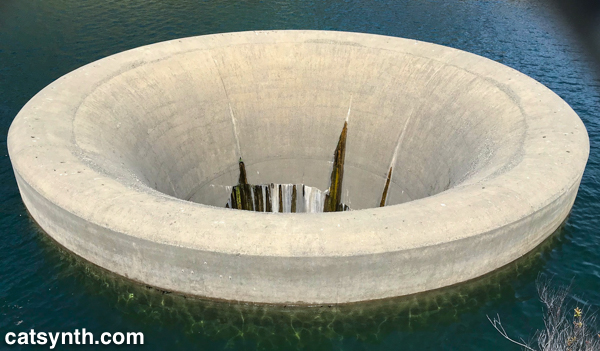
The “Glory Hole” spillway at the Monticello Dam at Lake Berryessa, California.

Our Volt Divers Cat-tastic edition show in Portland this past month raised funds for House of Dreams, a no-kill cat shelter that specializes in older cats and those with medical conditions that may make them more challenging to adopt out. I had the chance to visit the shelter and made this video from the experience.
House of Dreams is, quite literally, a house at a non-disclosed location in Northeast Portland. Most of the space is dedicated to the cats, who have can move about freely in their respective rooms. We saw cats doing what cats do: play, interact, eat, and nap. And they certainly get a lot of love and attention from the all-volunteer staff.
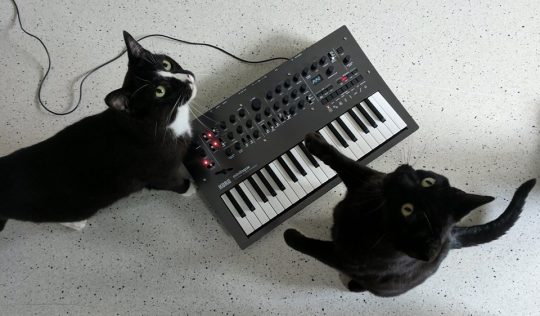
The is a separate section of the house for cats who have tested positive for feline leukemia (FeLV). FeLV-positive cats to have special medical needs, and should be with other FeLV-positive cats, but they can still lead happy and full lives. Indeed, a couple of the most playful cats I met while I was there were in the FeLV section.
This is Snowball, probably the biggest ham among the cats.
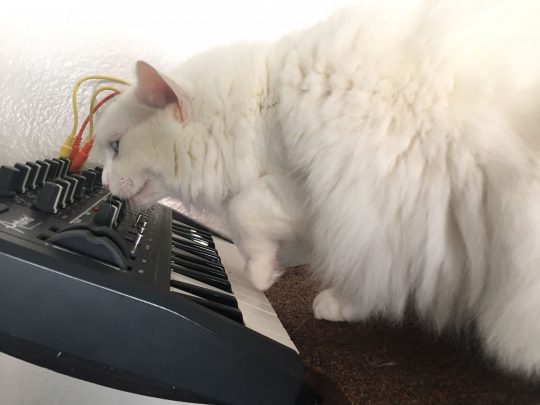
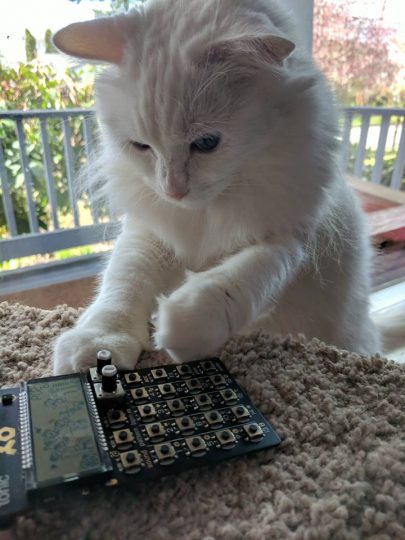
These “CatSynth pics” of the cats at House of Dreams were taken by our friend and Volt-Divers host Jeph Nor, a synthesizer virtuoso in his own right and human companion of Runkl.
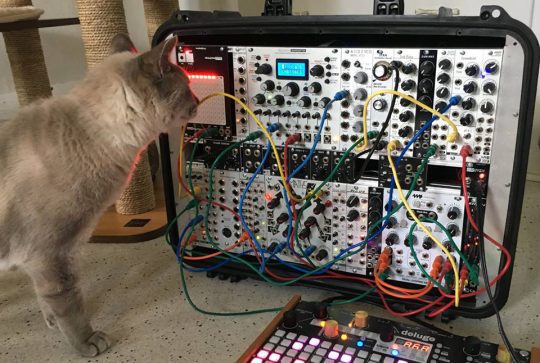
This is Sassy, who definitely had an attitude to match her name. (She appears at the end of our video giving us a “look” 😸). Below is sweet Spice.
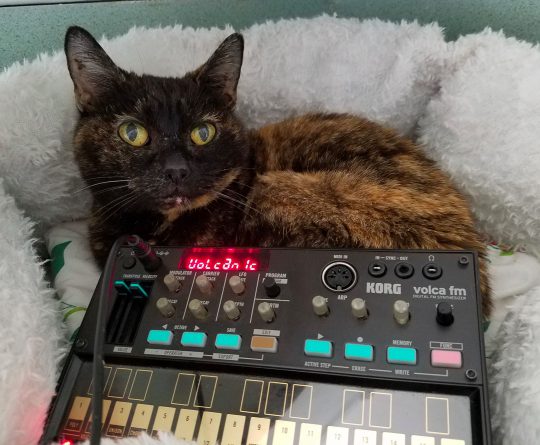
Flicka was one of my “tour guides” who followed me around.
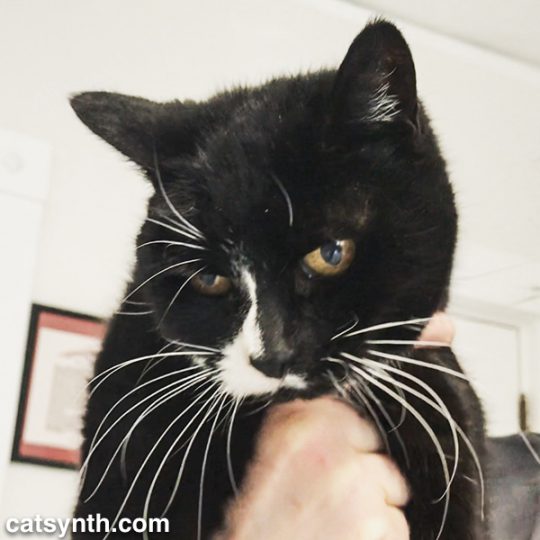
All the cats seemed pampered and well-loved by the staff. They had lots of personal attention (if they wanted it). Plus, the entire space was immaculate and full of furniture and toys to both stimulate and comfort the cats. As a small shelter focusing on cats with special needs, they have fewer overall adoptions – each one is a celebration, though often a farewell to a friend that the volunteers have grown to love. But they do have a good track record of adopting out, and often keep in touch with their “alumni” and human caregivers.
We at CatSynth were happy to visit and support them, both through our video and through the Volt Divers show. If you want to find out more about House of Dreams, including information on donations, please visit their website.
A week ago, I found myself back in Portland for the first time in four years. Officially, I was there to headline the Volt Divers Cat-tastic Edition show, but geat many other experiences large and small framed the main event. There were synths, cats, food, drink, and rain. Lots of cold rain. And wind. This is not unusual, but it did limit outdoor activities such as industrial and architectural photography. Instead, we enjoyed some of Portlanders’ favorite indoor activities, starting with brunch.
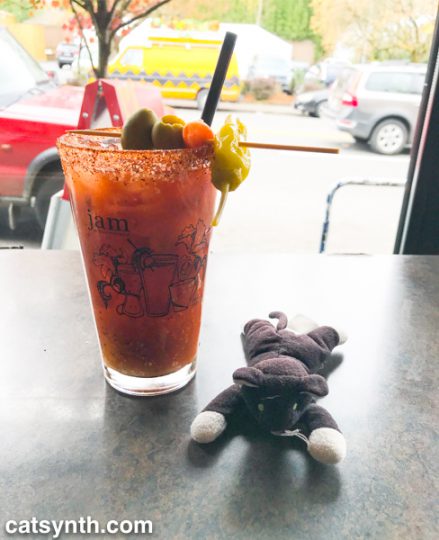
Portland may be an even “brunchier” place than San Francisco, Oakland, or Brooklyn, judging by the lines I observed at popular spots, including Jam on Hawthorne, not far from my home base in Southeast. Fortunately, as a solo patron who doesn’t mind squeezing into a tight spot at the bar, I didn’t have long to wait to get served. I quite enjoyed the spicy bloody-mary variant with Jam’s proprietary “aardvark sauce”, as well as the rancheros.
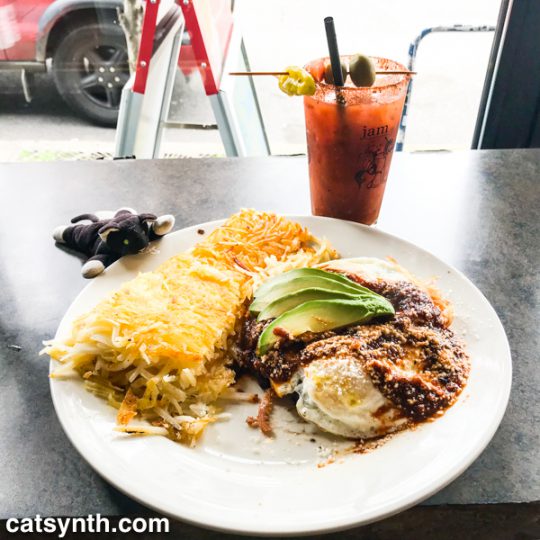
The sharper cheese sprinkled on top gave the dish an almost Italian quality, but it retained the hearty beans, spicy sauce, and simple eggs that made it perfect for a cold morning. The view out to Hawthorne Boulevard displayed some of the local flavors, including that Charlie-Brown-inspired van in the first photo.
Then it was back to our temporary “CatSynth HQ” to relax for a bit. Buddha, one of my hosts, made sure I felt at home. He was rather friendly, and even demanding of attention. I was happy to oblige.
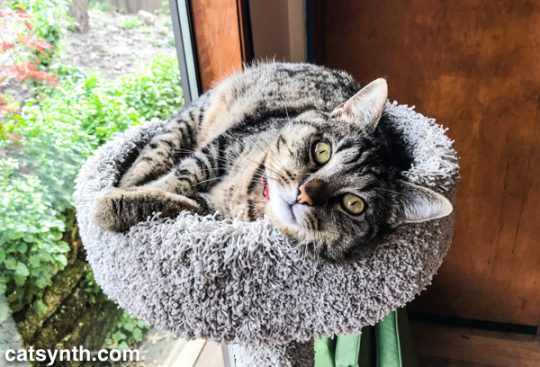
After some quality cat time, it was back out to Hawthorne, this time headed over the bridge to downtown. Downtown Portland is somewhere between the downtown sections of Oakland and Brooklyn in terms of cityscape and vibe, though on a smaller scale than the latter. It has a regular grid cut by the I-405 freeway and Burnside Street, and a mix of contemporary, mid-century and older buildings. It was at the base of one of the older buildings that I found a small hair salon that was able to fit me in for a last-minute blowout – the weather was not kind to my hair, and I needed to look purrfect for the show that evening.
 The next stop took me eastward from downtown to the ragged edges of the city along SE 82nd Avenue (State Route 213). I was here to pick up a borrowed Nord for the show. A mixture of auto-shops, low-rise apartments, and shopping centers made this area feel more like Los Angeles (except for the weather) or the far eastern sections of Queens. But it was still fascinating in its way, and there was an interesting row of shops, bars, and eateries along Stark Street – I wish I had a chance to stop at The Country Cat, but time did not permit this.
The next stop took me eastward from downtown to the ragged edges of the city along SE 82nd Avenue (State Route 213). I was here to pick up a borrowed Nord for the show. A mixture of auto-shops, low-rise apartments, and shopping centers made this area feel more like Los Angeles (except for the weather) or the far eastern sections of Queens. But it was still fascinating in its way, and there was an interesting row of shops, bars, and eateries along Stark Street – I wish I had a chance to stop at The Country Cat, but time did not permit this.
With hair done and keyboard secured, it was time to prepare for the show, which back in the industrial section of Southeast along the river at The Lovecraft Bar.
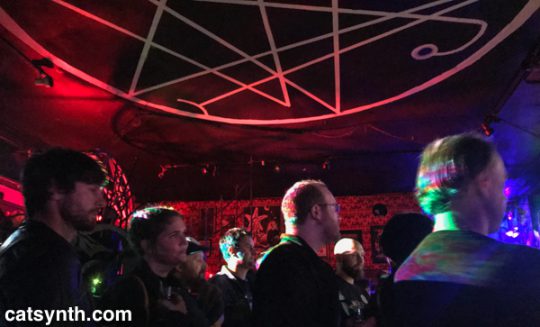
Inside the bar, it was dark. Really dark. It took me a few minutes before my eyes adjusted and I could see everyone else busily setting up their mostly modular rigs. It was all business after that as I set up for the show, but I did have some moments to check out the Lovecraft and horror-themed decor.
I will be covering the show itself in detail in a subsequent article. But we already have a video published on CatSynth TV, which you can view below.
 The next morning I found myself in the Hollywood neighborhood. It was actually the first time on this particular trip that I found myself north of Burnside in the northeast sector of the city. Sandy Boulevard was lined with a diverse collection of low-rise businesses. I crossed I-84/US 30 into the adjacent Grant Park district, which reminded me again of residential neighborhoods with larger lots at the edges of New York City into Westchester and Long Island. I had some personal appointments that morning but then remained in Northeast to visit House of Dreams cat shelter at their secure undisclosed location.
The next morning I found myself in the Hollywood neighborhood. It was actually the first time on this particular trip that I found myself north of Burnside in the northeast sector of the city. Sandy Boulevard was lined with a diverse collection of low-rise businesses. I crossed I-84/US 30 into the adjacent Grant Park district, which reminded me again of residential neighborhoods with larger lots at the edges of New York City into Westchester and Long Island. I had some personal appointments that morning but then remained in Northeast to visit House of Dreams cat shelter at their secure undisclosed location.
House of Dreams is a no-kill shelter specializes in cats that have difficulty finding homes and has space dedicated for FelV-positive cats (i.e., those with feline leukemia). Our show the night before raised funds for their shelter and work, and I of course wanted to come visit the kitties. We will dedicate an upcoming article and video entirely to House of Dreams, but for now here is a cute picture of Flicka, one of the many sweet cats I met there.

We then hopped onto I-84 back west towards the river, passing the convention center and on to Mississippi Street, a trendy area of boutiques, pubs, and restaurants. This is also the home of Control Voltage, a premier shop for synthesizers of all sorts. It was relatively easy to find with the sidewalk signage.
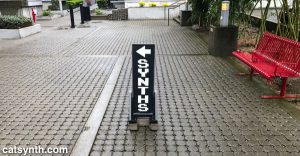
Among the many keyboard and modular displays was this rack featuring modules from FolkTek, one of several local makers in the Portland area. They do have a gorgeous design.
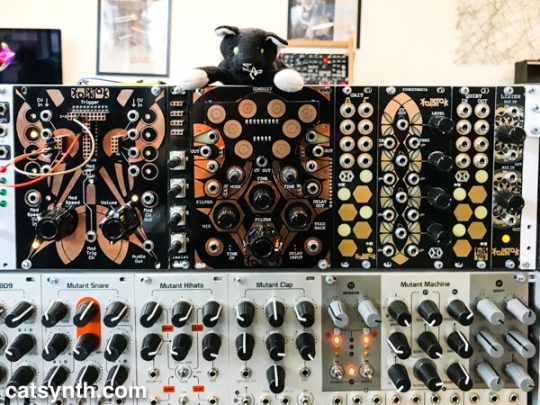
I chatted with the staff and shot some video for an upcoming CatSynth TV, but also walked away with one of the FolkTek modules, a quad envelope follower that I know will come in handy for some upcoming music projects.
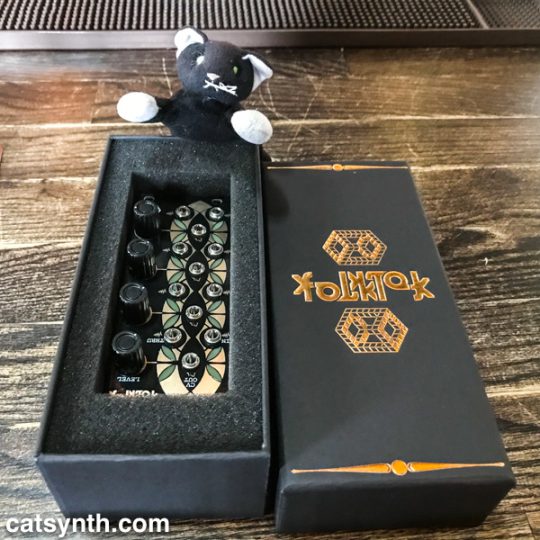
I wandered a few blocks south on Mississippi to StormBreaker Brewing, which I had remembered from a previous trip. In addition to their beer offerings, they had several suggested beer-and-whiskey pairings, which I of course had to try.
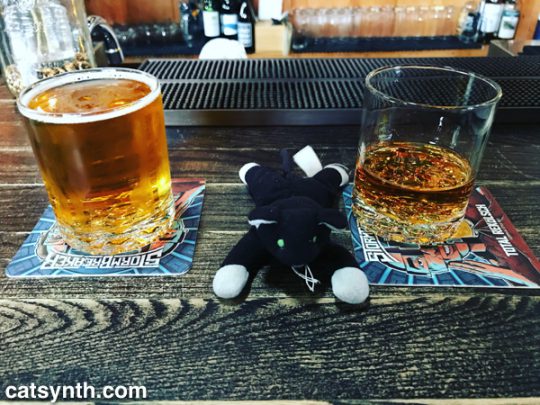
One of the daily specials, a cream-of-asparagus soup, was perfect for that cold and rainy afternoon.
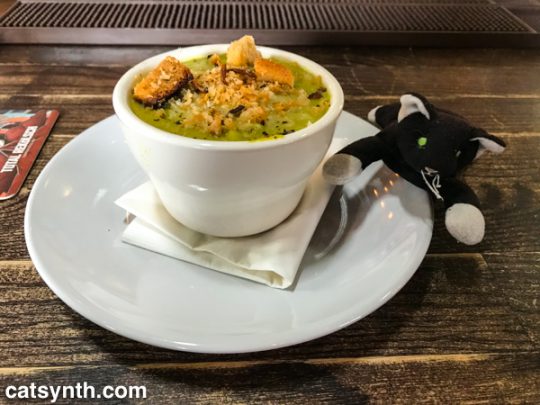
Although this trip took me to quite a few corners of the city, I still felt there was much undone, especially meeting more of the local synth community, and spending some time outdoors. So I do expect to be back much sooner than last time.
See more of Portland, Oregon and many other fascinating places in our Highway☆ app, available on the Apple App Store and Google Play Store.

Last night in downtown Brooklyn, we observed the 9/11 Tribute in Light turning on across the river. One beam was on first, and then later – following the pattern of the towers attack and collapse.
It is a somber reminder. And it is the second time I have been in New York on 9/11 to witness it.
You can read more about the 9/11 Tribute in Light here.
On the Friday after Thanksgiving, I visited the New Museum in New York, which dedicated all its galleries to video works during this time. Three of the museum’s floors were dedicated to a retrospective of the Swiss video and media artist Pipilotti Rist. It is the first major retrospective of her work in New York.
The title piece of the exhibition filled most of the third floor gallery. The huge immersive piece consisted of hanging strands of resin beads with LEDs that gradually changed colors in a uniform synchronous manner.

Viewers were encouraged to walk among the strands, bumping and even touching the surfaces which had a somewhat oily feel to them. There was a certain hypnotic beauty to the experience, even with the large number of other visitors wandering through. The effect was completed by water sounds throughout the space.
The floor below featured some of Rist’s earlier works, including some of her single channel videos. There was one that featured close-ups people people eating, but also growing vegetation and an appearance by a cat.

But even these single channel videos were projected onto moving curtains which allowed visitors to move among the pieces, becoming part of the larger installation. A small set of elliptical laser lights also moved about the lower gallery.

One corner featured a series of larger two-panel video works. I was particularly taken with this one featuring a nicely dressed woman smashing car windows with the stalk of a plant that was shown growing in a field in some clips.

The top floor of the gallery showed Rist’s newest pieces, which placed video and media into architectural spaces. This sight-specific piece projected irregular aquatic video onto the ceiling while views lay below on beds. Nearby was another much smaller architectural piece featuring a bedroom and a model of the moon with video projection.

It was quite adorable, but showed how the architectural focus of her most recent works could be done on multiple scales, very large and very small.
The ground floor gallery featured a series of video works by Chinese artist Cheng Ran. The exhibition, titled Diary of a Madman was based on Cheng’s three-month residence in New York with the New Museum. Based on a Chinese short story written in 1918, the videos were shot and editing in New York and feature a variety of locations, including an abandoned psychiatric hospital on Long Island. I found the combination of bleak spaces with musical elements to be quite interesting.

A visit to the New Museum often includes a visit to the observation deck on the top floor. It was a cold but clear day which provided for a good view of the changing skyline of lower Manhattan.

Overall, it was a good visit to the museum. But I was far from alone, as it was quite crowded with a line waiting to get in. I suppose on a dreary day when so many are running around shopping, a dark museum is a very inviting place indeed.
For us at CatSynth, coming back to New York almost always means a visit to Museum of Modern Art (MoMA). It’s a place that is always safe, inviting and inspiring. It’s also a change to spend time with some old friends, like Piet Mondrian’s Broadway Boogie Woogie, a painting that for me has an almost religious significance.

There are of course, many special exhibitions, and we discuss them below.
Much of the top floor of the museum was reserved for a retrospective of the work of Francis Picabia, one of the less-well-known of the great modern artists from the first half of the 20th Century. Though known for his association with the Dada movement, his oeuvre includes many other ever-changing styles. Indeed, the exhibition begins with his early works in an impressionist style. Though very well executed, they are not particularly exciting other than the provocative nature (for the time) of using photographs as sources. However, after this initial period, his work explodes with large abstract canvases.

[Francis Picabia. Udnie (Jeune fille américaine; danse) (Udnie [Young American Girl; Dance]). 1913. Oil on canvas, 9′ 6 3/16″ × 9′ 10 1/8″ (290 × 300 cm). Centre Pompidou, Musée national d’art moderne – Centre de création industrielle, Paris. Purchased by the State, 1948. © 2016 Artist Rights Society (ARS), New York/ADAGP, Paris. Photo: © Centre Pompidou, MNAM-CCI/Georges Meguerdtchian/Dist. RMN–Grand Palais/Art Resource, New York.]
The painting shown above, Udnie (Jeune fille américaine; danse) (Udnie [Young American Girl; Dance]) is exemplary of this period of his work. It is huge, almost 10 feet by 10 feet square, and features bright industrial colors with large curving lines. This painting had a colder and higher-contrast palette than its neighbors, so it particularly attracted me. There is also the fact that the title reminds me of the David Bowie album of similar name.
Picabia became a leading artist in the Dada movement, producing many paintings and drawings of industrial and manufactured objects, some featuring bits of text that he found from encyclopedias and other sources. They have the sparse, sometimes sad quality of readymades, but also show steady and disciplined hands at work to create these pieces.

The centerpiece of the Dada sections of the exhibition was a recreation of one of his Paris exhibitions, with drawings arranged in a linear fashion and rugs along the gallery floor. The pieces were a mixture of Dada, abstraction and figurative images (mostly of Spanish women). These demonstrate the artist’s desire to not be stuck in one style or even just one movement.
Picabia went through a period of more figurative painting in the years leading up to and during World War II, including a somewhat odd set of photorealistic paintings from soft-porn images that he created while living in under the Vichy regime in southern France. After the war, however, he returned to abstraction until his death in 1953. Many of these late works have a somewhat minimal quality, including a series consist of large dots on a monochromatic background
The other major exhibition on the top floor featured a full-gallery installation by Kai Althoff entitled and then leave me to the common swifts (und dann überlasst mich den Mauerseglern). The space itself was the artwork in which the viewer was invited to wander.

[Installation view of Kai Althoff: and then leave me to the common swifts (und dann überlasst mich den Mauerseglern). The Museum of Modern Art, New York, September 18, 2016–January 22, 2017. Photograph © Kai Althoff]
The labyrinthine installation is a seeming clutter of objects, looking more like a messy artists’ studio. However, on closer inspection, one sees that there are a lot of older works from the artist in various states of integrity among found objects like dolls and clothing. The artwork fragments included heads with strange expressions. Overall, it was one of the more confounding exhibitions I have seen. I am not one to necessary require “meaning” from art, but I do tend to look for lines, shapes and patterns. But being challenged by an exhibition is not a bad thing.
In addition to the hunt for old favorites in the permanent collection, an entire floor was dedicated to works from he 1960s, arranged one room per year. The detailed view shows just how rich and varied the art of that decade was, and how art transformed into what we think of as contemporary in the early 21st Century. Among the works on display was a set of photographs by Bernd and Hilla Becher. We have discussed them before, as their work is very influential for my own art photography.

The video work of Nam June Paik has also been a major influence. The exhibition featured a very minimal work of his, essentially reducing analog video to a single line.

Yayoi Kusama is enjoying a lot of attention of late. This work, which appeared to be a chair of penises, was featured prominently. The description of the piece confirmed my phallic interpretation.

The second floor also featured multiple special exhibitions, including the provocative “architectural” show on displacement and shelter, focusing on migrants and refugees in the modern world. It included a full-size refugee tent shelter, as well as overhead images of a sea of such shelters. There were images from camps that have been in the news lately, such as the large one in Callais, France. There were also some art pieces on the same theme, such as lightboxes with images of war zones by Tiffany Chung.

[finding one’s shadow in ruins and rubble. Tiffany Chung, 2014. Courtesy of the artist and Tyler Rollins Fine Art]
There was also a large world map with strings representing patterns of migration, along with sound and visual elements. Not surprisingly, a great many of those lines led to the United States.

It’s a reminder that the U.S. has always been a welcoming country for refugees and immigrants, and will hopefully remain so.
There is always more that I saw and resonated with an I can fit in such an article. Please visit us on Instagram to see more of our latest visit to the MoMA.

Geometric and texture study from the Port of Long Beach, 2014. You can read more and see more images from my visit here.